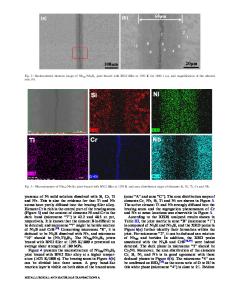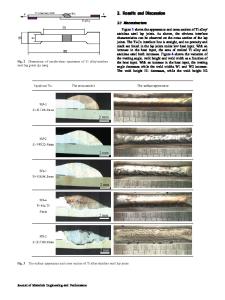Microstructural Evolution and Mechanical Properties of Nickel-Base Superalloy Brazed Joints Using a MPCA Filler
- PDF / 2,100,635 Bytes
- 11 Pages / 593.972 x 792 pts Page_size
- 1 Downloads / 382 Views
are among the most important classes of engineering materials. Their good corrosion resistance under aqueous and high-temperature conditions, high strength at elevated temperatures, and good ductility and toughness at low temperatures make
MINRUI GAO, BENJAMIN SCHNEIDERMAN, SARAH M. GILBERT, and ZHENZHEN YU are with the George S. Ansell Department of Metallurgical and Materials Engineering, Colorado School of Mines, 1500 Illinois St., Golden, CO, 80401, USA. Contact e-mail: [email protected]. Manuscript submitted February 21, 2019.
METALLURGICAL AND MATERIALS TRANSACTIONS A
them excellent candidates for a variety of applications.[1–6] Certain alloying additions can tailor these alloys to be applied in a wide range of industries, such as power generation, petrochemical and chemical processing, aerospace, and pollution control. However, Ni-base alloys that are optimized for performance are generally not optimized for welding in fabrication or repair. Considerable research has been conducted over the past 50 years focusing on techniques for joining and refurbishing components made of Ni-base superalloys, including fusion welding, solid-state diffusion, and brazing.[7] During fusion welding processes, most of the Ni-base alloys are susceptible to fusion zone solidification cracking, heat-affected zone (HAZ) liquation cracking, ductility-dip cracking, and strain-age
cracking due to their face-centered cubic (FCC) crystal structure, segregation of alloying elements, and localized stresses.[8–15] Solid-state diffusion bonding requires perfect alignment and considerable pressure (e.g., 500-5000 psi), which limits its applications.[7,16] In contrast, brazing techniques require no pressure or jigging, and they operate at temperatures lower than the melting point of the parent metals, thus avoiding the formation of defects associated with solidification while generating less distortion and shrinkage.[17–20] Moreover, brazing is conducted in a vacuum chamber or inert atmosphere, which prevents oxidation in Ni-base superalloys. Nickel-base filler metals such as Ni-Cr-B[21] and Ni-B[15,17,22] in the form of wire, foil, powder, and powderSi flux paste are commonly used for the joining and repair of hot-section components of aircraft and power generation turbines made of Ni-base superalloys.[23,24] Melting point depressants such as boron, silicon, and/or phosphorous are added to these filler metals to lower the melting temperature below that of the base materials and thus avoid excessive interactions at the joint interface. However, the addition of these elements leads to the formation of brittle borides, silicides, and/or phosphides. They are detrimental to the mechanical properties and corrosion/oxidation resistance of the brazed joints, especially if they form a continuous network along the grain boundaries[21,24–27]. Moreover, the intermetallic phases could reduce the re-melting temperature, and therefore the service temperature of the brazed components, due to the segregation of melting point depressants into the eutectic microstructu
Data Loading...











